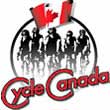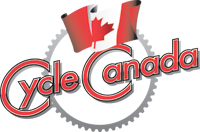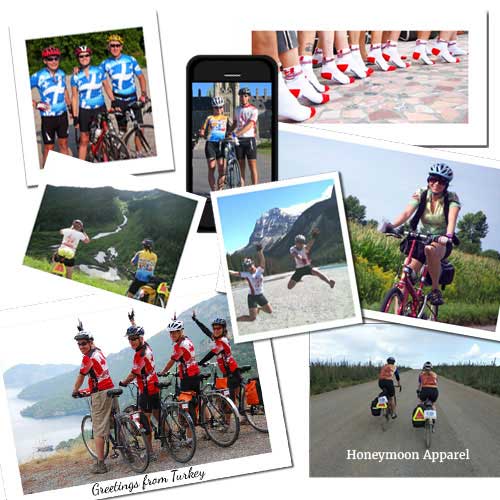Cycle Canada Blog
Choosing a Road Bike
by Bud Jorgensen
Most of the roads that we take on Cycle Canada trips are paved and we recommend a road bike for those rides.
These tips by Bud Jorgensen, founder of Tour du Canada and owner/operator of Cycle Canada . Reflecting his personal views from more than 40 years of recreational riding.
The Frame
For distance riding, my bias is towards an alloy steel frame with touring angles. With racing angles, performance is better but you will feel the bumps more on long trips. Angles referred to are those of the head and seat tubs relative to the ground or top tube. With a high number, the angles are steeper and you get more direct and efficient power to the pedals.
Aluminum and carbon fibre frames are better able to absorb shock, which still allows the tight angles that come with a high performance frame. And if you have the money, titanium combines the good qualities of steel with lightness of aluminum.
But be cautious about new frame materials. In some models, there is some evidence of fatigue at joints where the tubes come together. Anyone considering a non-steel frame should check the pedigree of the builder and look into the performance record.
Drive Train
While I'm willing to swap performance for comfort on the frame of a touring bike, I've always gone for performance in the drive train. That means changers that give me quick, efficient shifts and a high-quality, light crankset. However, I do give up a bit of weight on the pedals because they take a lot of abuse and sturdy pedals last.
Wheels
One of the old cycling sayings says an ounce on the wheels is worth a pound on the frame. The weight you're pushing around at the periphery of the wheel is much more significant than the weight of your frame and components that get carried along. That's why I've always gone for lightweight rims and tires.
New rim designs make the 20 mm (less than one inch) models as strong or stronger than the 32 mm (1 1/4-inch) models of a few years back. Still, when you ride light tires and rims you have to take more care when crunching over gravel and railroad tracks.
So you must make an assessment of your riding style when deciding how light to go.Handlebars
Drop handlebars allow more efficient riding. A solo cyclist uses about 80 per cent of pedalling energy in pushing aside the wind. Thus, a lower profile for the rider makes for easier riding.
One of those bits of information that many bike books don't provide is that handlebars come in different widths. For touring, a wider bar is more comfortable and more easily accommodates a handlebar bag.
Gearing
My biggest complaint about companies that build bikes for the recreational market is that they often gear bikes too high. A 52-42 set of rings on the front is standard for an entry-level racing bike and builders often copy that configuration for touring models. Most tourists simply do not need a 52-tooth chainring on the front. A related pet peeve is that bike shops will sell people bigger sprockets for the back to gear down a bike.
If you want to gear down, go to smaller chainrings on the front. Using larger sprockets on the back simply adds weight to the drive train. Note that some cranksets only go down to 42-tooth rings. When shopping for a crankset, check the range of available rings.
When buying a bike, or if you are thinking about changing gearing on a bike you now have, do some research. Any standard cycling reference book will contain a gear chart. John Forester's book, Effective Cycling, is one that has considerable detail on gearing.
In planning for long-distance riding, consider carefully whether you need a triple front chainring. A triple will allow you to gear down to a quite-low ratio. If you are prone to sore knees, you should have a low gear so that you can spin at a higher cadence up those hills.
Saddles
I like a leather saddle. It breathes and avoids that clammy feeling. True, some can be uncomfortable to break in. But once broken in, the saddle fits your anatomy. Leather saddles do require maintenance with saddle soap or something similar.
Mirror
A mirror is an essential accessory. Those that fit on a helmet or a pair of glasses are lightweight and do the job. Ones that fit onto the handlebars give a better view if properly designed. You need to spend a few dollars to get one that works well.
Racks
Whether you want a rack on your bike is one of those personal preference questions. You can pack a lot in rear pockets of a jersey and a basic tool kit will fit under the saddle. But if you're carrying a camera and rain gear, you probably will want a bike bag. Your choice is handlebar bag or a rack that accommodates a rear trunk. A front bag will have some effect on bike steering.
Fenders
With fenders, you won't get that stripe of mud up your back when the roads are wet. More important, you can ride in a group without offending other riders by your spray.
Lights and Reflective Clothing
We don't anticipate any night riding on our trips. But if you are out at night you should have a front light for clear vision and a red tail light so that you can be seen. And you should wear reflective clothing at night. A battery operated bike light with a halogen bulb is a handy addition to your kit for bad weather or an evening trip to a corner store. And it doubles as a flashlight on camping trips.
To download a printable sheet of this article visit: Choosing a Road Bike.
Archives
Newsletters
Blogs

About Cycle Canada
Cycle Canada, The Veloforce Corporation is a Canadian owned and operated company. Cycle Canada has been offering affordable supported bicycle tours throughout Canada since 1988. Tours range from a 2 day, one week, two week to 10 weeks. Cyclists travel exclusively in Canada and in all 10 provinces with a range of challenge levels.
For a listing of all tours visit: Cycle Canada Tours
And to learn more about Cycle Canada and its activities visit: Cycle Canada
Wave the Flag
Shop at the Cycle Canada Store


